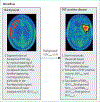PET-based response assessment criteria for diffuse gliomas (PET RANO 1.0): a report of the RANO group
- PMID: 38181810
- PMCID: PMC11787868
- DOI: 10.1016/S1470-2045(23)00525-9
PET-based response assessment criteria for diffuse gliomas (PET RANO 1.0): a report of the RANO group
Abstract
Response Assessment in Neuro-Oncology (RANO) response criteria have been established and were updated in 2023 for MRI-based response evaluation of diffuse gliomas in clinical trials. In addition, PET-based imaging with amino acid tracers is increasingly considered for disease monitoring in both clinical practice and clinical trials. So far, a standardised framework defining timepoints for baseline and follow-up investigations and response evaluation criteria for PET imaging of diffuse gliomas has not been established. Therefore, in this Policy Review, we propose a set of criteria for response assessment based on amino acid PET imaging in clinical trials enrolling participants with diffuse gliomas as defined in the 2021 WHO classification of tumours of the central nervous system. These proposed PET RANO criteria provide a conceptual framework that facilitates the structured implementation of PET imaging into clinical research and, ultimately, clinical routine. To this end, the PET RANO 1.0 criteria are intended to encourage specific investigations of amino acid PET imaging of gliomas.
Copyright © 2024 Elsevier Ltd. All rights reserved.
Conflict of interest statement
Declaration of interests NLA has received honoraria for consultation or advisory board participation from Novartis (Advanced Accelerator Applications), Telix Pharmaceuticals, and Servier; and research funding from Novocure. NG received honoraria for lectures from Blue Earth Diagnostics and honoraria for advisory board participation from Telix Pharmaceuticals. BME is on the advisory board and is a paid consultant for Medicenna, MedQIA, Servier Pharmaceuticals, Siemens, Janssen Pharmaceuticals, Imaging Endpoints, Kazia, Chimerix, Sumitomo Dainippon Pharma Oncology, ImmunoGenesis, Ellipses Pharma, Monteris, Neosoma, Alpheus Medical, Sagimet Biosciences, Sapience Therapeutics, Orbus Therapeutics, and the Global Coalition for Adaptive Research. MJvdB has received honoraria from Roche, AstraZeneca, Servier, Boehringer, Genenta, Fore Biotherapeutics, Incyte, and Nerviano. ELR reports personal financial interests as an advisory board member for Bayer, Janssen, Leo Pharma, Pierre Fabre, Roche, Seattle Genetics, and Servier; and institutional funding from Bristol Myers Squibb. MJM has received research support from Bristol Myers Squibb and travel support from Pierre Fabre. GM has received honoraria for lectures from BrainLab. RR has received research grants from Bayer, and honoraria for lectures or consulting from UCB, Novocure, Genenta, Curevac, and Servier. AMS has received research support to his institution from Medimmune, AVID, Telix Pharmaceuticals, ITM, Fusion, Cyclotek, Adalta, TheraMyc, Curis, Humanigen, and Antengene; funding support from the Medical Research Future Fund, Australian Brain Cancer Mission, Cure Brain Cancer Foundation, National Breast Cancer Foundation, Australian Cancer Research Foundation, National Imaging Facility, and Victorian Cancer Agency; and is a National Health and Medical Research Council Investigator. MS has received honoraria for consultancy from Bracco and honoraria for lectures from GE Healthcare, AuntMinnie, and Fondazione Internazionale Menarini (all paid to their institution). BS has received honoraria for lectures and consultation from Novocure. J-CT has received honoraria for lectures, consultation, or advisory board participation from SeagGen, AAA-Novartis, Novocure, and Munich Surgical Imaging. AV has received honoraria for lectures and advisory board participation from Curium, Eisai, and General Electrics. MW has received research grants from Quercis and Versameb; and honoraria for lectures or advisory board participation or consulting from Bayer, Curevac, Medac, Novartis, Novocure, Orbus, Philogen, Roche, and Servier. PYW has received research support from AstraZeneca, Black Diamond, Bristol Myers Squibb, Celgene, Chimerix, Eli Lilly, Erasca, Genentech/Roche, Kazia, MediciNova, Merck, Novartis, Nuvation Bio, Servier, Vascular Biogenics, and VBI Vaccines; and honoraria for serving as a consultant or on advisory boards for AstraZeneca, Black Diamond, Celularity, Chimerix, Day One Bio, Genenta, GSK, Merck, Mundipharma, Novartis, Novocure, Nuvation Bio, Prelude Therapeutics, Sapience, Servier, Sagimet, Vascular Biogenics, and VBI Vaccines. MP has received honoraria for lectures, consultation, or advisory board participation from Bayer, Bristol Myers Squibb, Novartis, Gerson Lehrman Group, CMC Contrast, GSK, Mundipharma, Roche, BMJ Journals, MedMedia, AstraZeneca, AbbVie, Lilly, Medahead, Daiichi Sankyo, Sanofi, Merck Sharp & Dohme, Tocagen, Adastra, Gan & Lee Pharmaceuticals, and Servier; and travel support from Servier, Roche, and Medsir.
Figures



References
-
- Wen PY, Macdonald DR, Reardon DA, et al. Updated response assessment criteria for high-grade gliomas: response assessment in neuro-oncology working group. J Clin Oncol 2010; 28: 1963–72. - PubMed

